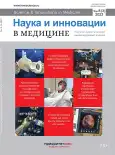Технологии расчета и визуализации статистики распространенности и заболеваемости на примере сведений о полипозном риносинусите в Самарской области
- Авторы: Палевская С.А.1, Гущин А.В.1, Блашенцев М.К.1
-
Учреждения:
- ФГБОУ ВО «Самарский государственный медицинский университет» Минздрава России
- Выпуск: Том 8, № 3 (2023)
- Страницы: 189-197
- Раздел: Общественное здоровье, организация и социология здравоохранения
- URL: https://bakhtiniada.ru/2500-1388/article/view/249948
- DOI: https://doi.org/10.35693/2500-1388-2023-8-3-189-197
- ID: 249948
Цитировать
Полный текст
Аннотация
Цель – определить в статистическом смысле особенности распределения хронических заболеваний в хронологии наблюдений; показать специфику приемов проверок гипотез в количественном и вероятностном прогнозе распространяемости полипозного риносинусита.
Материалы и методы. Использованы данные случаев амбулаторно-поликлинической помощи за 2017–2021 годы и количественные сведения о зарегистрированных основных или сопутствующих фактах заболеваний полипозным риносинуситом в медицинских организациях в 25 районах Самарской области.
Результаты. Синтез статистик исходных данных, которые составили объем числового расширения первичных показателей в следующем соотношении: категории 15,8%, счетные данные 26,3%; количественные значения 21,1%; 26,7% – это относительные данные заболеваемости и распространенности. Оставшийся объем – это описательная статистика и показатели в виде таблиц коэффициентов корреляций. Для синтезированных расширений данных произведены оценки распределений и проверки гипотез с использованием статистических критериев.
Выводы. Счет числа заболеваний хронического характера аппроксимируются плотностями атипичных распределений. Приблизительно 58% выборок по диагнозам не подтверждаются, подчиняясь закону распределения. В подобной ситуации при подготовке прогноза для перехода к временному ряду необходимо решать проблему получения последовательностей со стационарными характеристиками. При машинном обучении данные в расчетах предсказания должны пройти проверку на вероятностное подтверждение совпадения распределений параметров связанных выборок. Результаты прогноза следует воспринимать как вероятностный вывод на уровне неотвергаемой гипотезы.
Полный текст
Открыть статью на сайте журналаОб авторах
С. А. Палевская
ФГБОУ ВО «Самарский государственный медицинский университет» Минздрава России
Email: s.a.palevskaya@samsmu.ru
ORCID iD: 0000-0001-9263-9407
д-р мед. наук, MBA, профессор МВА, директор ИПО
Россия, СамараАндрей Викторович Гущин
ФГБОУ ВО «Самарский государственный медицинский университет» Минздрава России
Автор, ответственный за переписку.
Email: a.v.guschin@samsmu.ru
ORCID iD: 0000-0002-6128-2334
канд. техн. наук, доцент кафедры менеджмента ИПО
Россия, СамараМ. К. Блашенцев
ФГБОУ ВО «Самарский государственный медицинский университет» Минздрава России
Email: mblashentsev@gmail.com
ORCID iD: 0000-0002-9820-4292
аспирант кафедры оториноларингологии им. академика РАН И.Б. Солдатова, ассистент ФАЦ
Россия, СамараСписок литературы
- You J, Tulpan D, Malpass MC, et al. Using machine learning regression models to predict the pellet quality of pelleted feeds. Animal Feed Science and Technology. 2022;293:115443. doi: 10.1016/j.anifeedsci.2022.115443
- Hu Y, Xia X, Fang J, et al. A Multivariate Regression Load Forecasting Algorithm Based on Variable Accuracy Feedback. Energy Procedia. 2018;152:1152-1157. doi: 10.1016/j.egypro.2018.09.147
- Kumari Kh, Yadav S. Linear regression analysis study. Curriculum in cardiology – statistics. 2018;4(1):33-36. doi: 10.4103/jpcs.jpcs_8_18
- Almalik O. Combining dependent p-values resulting from multiple effect size homogeneity tests in meta-analysis for binary outcomes. Journal of Medical Statistics and Informatics. 2021;1. doi: 10.7243/2053-7662-10-1
- Hart J. Comparison of p-value results between one versus two sample t testing: A case study. Journal of Medical Statistics and Informatics. 2021;10. doi: 10.7243/2053-7662-9-1
- Iftikhar S. Modification in inter-rater agreement statistics-a new approach. Journal of Medical Statistics and Informatics. 2020;8(1):2. doi: 10.7243/2053-7662-8-2
- Basu A. Does a country’s scientific ‘productivity’ depend critically on the number of country journals indexed? Scientometrics. 2010;3. doi: 10.1007/slll92-010-0186-8
- Almalki A. Regression Analysis for COVID-19 Infections and Deaths Based on Food Access and Health Issues. Healthcare. 2022;10(2):324. doi: 10.3390/healthcare10020324
- Silhavy R, Silhavy P, Prokopova Z. Analysis and selection of a regression model for the Use Case Points method using a stepwise approach. Journal of Systems and Software. 2017;125:1-14. doi: 10.1016/j.jss.2016.11.029
- Trubiani C, Ghabi A, Egyed A. Exploiting traceability uncertainty between software architectural models and extra-functional results. Journal of Systems and Software. 2017;125:15-34. doi: 10.1016/j.jss.2016.11.032
- García-Floriano A, López-Martín C, Yáñez-Márquez C, et al. Support vector regression for predicting software enhancement effort. Information and Software Technology. 2018;97:99-109. doi: 10.1016/j.infsof.2018.01.003
- Bach P, Wallisch Ch, Klein N, et al. Systematic review of education and practical guidance on regression modeling for medical researchers who lack a strong statistical background: Study protocol. National Library of Medicine, 2020;21;15(12). doi: 10.1371/journal.pone.0241427
- Rambotti S, Breiger RL. Extreme and Inconsistent: A Case-Oriented Regression Analysis of Health, Inequality, and Poverty. Sage. 2020;18. doi: 10.1177/2378023120906064
- Crabtree BF, Ray SC, Schmidt PM, et al. The individual over time: Time series applications in health care research. Journal of Clinical Epidemiology. 1990;43(3):241-260. doi: 10.1016/0895-4356(90)90005-A
- Festag S, Denzler J, Spreckelsen C. Generative adversarial networks for biomedical time series forecasting and imputation. Journal of Biomedical Informatics. 2022;129:104058. doi: 10.1016/j.jbi.2022.104058
- Morid MA, Sheng Ol, et al. Time Series Prediction Using Deep Learning Methods in Healthcare. Transactions on Management Information Systems. 2023;14(1):1-29. doi: 10.1145/3531326
Дополнительные файлы











